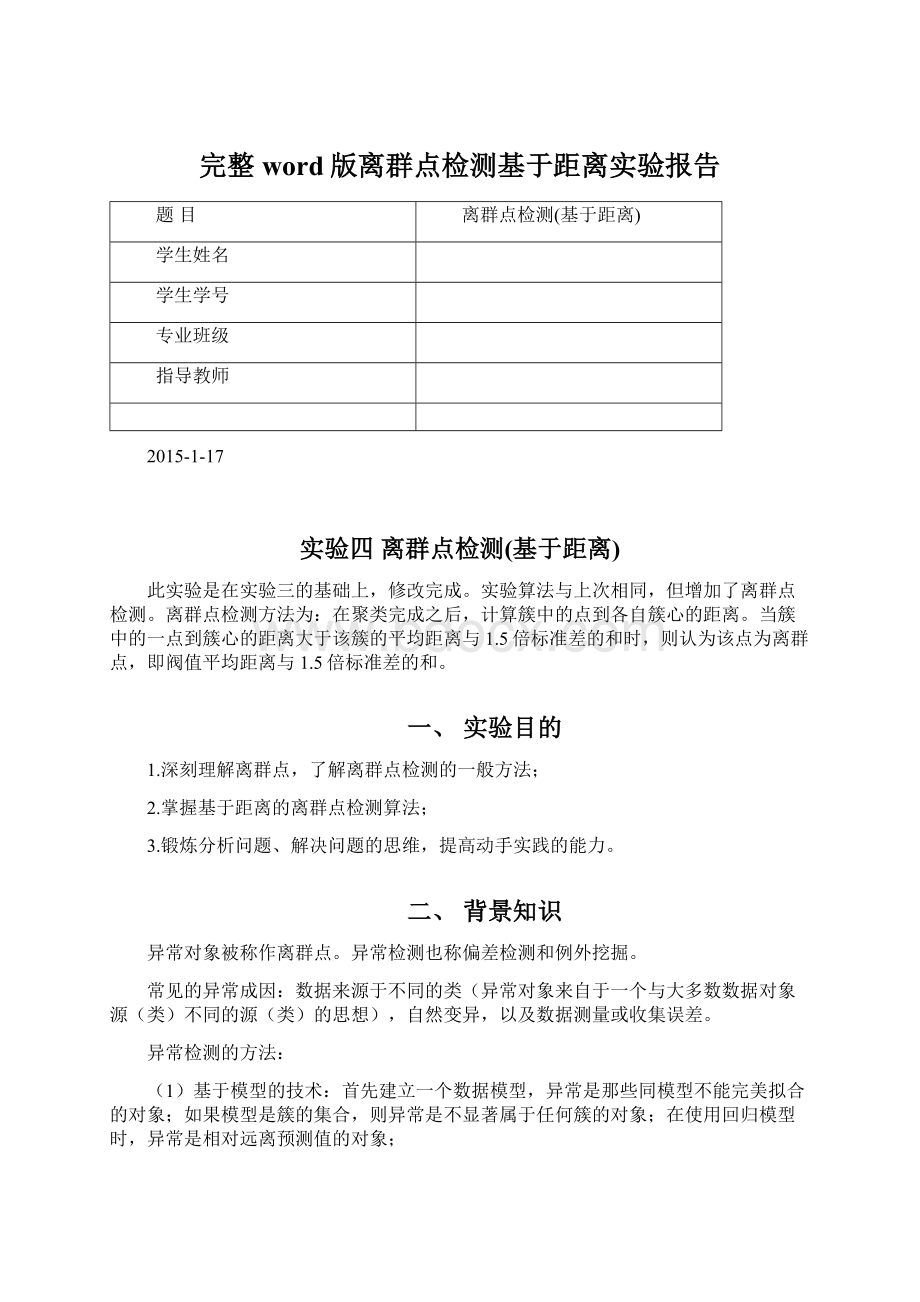完整word版离群点检测基于距离实验报告Word文档下载推荐.docx
《完整word版离群点检测基于距离实验报告Word文档下载推荐.docx》由会员分享,可在线阅读,更多相关《完整word版离群点检测基于距离实验报告Word文档下载推荐.docx(17页珍藏版)》请在冰豆网上搜索。

C++
五、算法描述
K-means算法是很典型的基于距离的聚类算法,采用距离作为相似性的评价指标,即认为两个对象的距离越近,其相似度就越大。
该算法认为簇是由距离靠近的对象组成的,因此把得到紧凑且独立的簇作为最终目标。
1、算法思路
K-means算法
先随机选取K个对象作为初始的聚类中心。
然后计算每个对象与各个种子聚类中心之间的距离,把每个对象分配给距离它最近的聚类中心。
聚类中心以及分配给它们的对象就代表一个聚类。
一旦全部对象都被分配了,每个聚类的聚类中心会根据聚类中现有的对象被重新计算。
这个过程将不断重复直到满足某个终止条件。
终止条件可以是以下任何一个:
1)没有(或最小数目)对象被重新分配给不同的聚类。
2)没有(或最小数目)聚类中心再发生变化。
3)误差平方和局部最小。
2、算法步骤
a.从数据集中随机挑K个数据当簇心;
b.对数据中的所有点求到这K个簇心的距离,假如点Pi离簇心Si最近,那么Pi属于Si对应的簇;
c.根据每个簇的数据,更新簇心,使得簇心位于簇的中心;
d.重复步骤e和步骤f,直到簇心不再移动(或其他条件,如前后两次距离和不超过特定值),继续下一步;
e.计算每个簇的正常半径,即阀值(此程序阀值为每个簇的平均距离与1.5倍标准差之和);
f.从每个簇中,找出大于阀值的点,即离群点。
六、数据结构
Node类,定义了二维空间中的一个点,pos_x,pos_y三成员变量分别为x,y,轴的值,且为double型。
Node类作为基本数据结构,使用在KMean类里。
KMean类封装了一系列成员变量和函数,实现了KMean算法。
具体成员变量和函数详细说明如下:
classKMean
{
private:
intcluster_num;
//生成的簇的数量。
vector<
Node>
mean_nodes;
//均值点
data;
//所有的数据点
*clusters;
//簇,key为簇的下标,value为该簇中所有点
intcount;
//记录迭代次数
*cutData;
double*radio;
//初始化函数(首先随即生成代表点)
voidInit_Means();
//聚类过程,将空间中的点分到不同的簇中
voidClusterProcess();
//获取当前结点的簇下标
intgetIndexOfCluster(vector<
means,Nodeactive);
//获取每个点到各自簇中心的距离和
doublegetSumOfDist(vector<
*clusters,vector<
mean_nodes);
//生成均值
NodegetMeans(intcluster_index);
//获取两个点之间的距离
doublegetDistance(Nodeactive,Nodeother);
public:
//构造函数,c_num为簇个数,node_vector为原始数据
KMean(intc_num,vector<
node_vector);
~KMean();
//找出离群点只要距离大于平均距离+标准差,则视为离群点
voidcut();
//显示剪枝结果
voidshowCutResult();
};
程序代码图
注:
代码图中相关函数的说明见KMean类的方法说明。
七、程序截图
随机生成50个数据,随机选取4个簇心,如上图所示。
经过聚类,簇1、簇2的中心已改变,算出的阀值、检测到的离群点如上图所示。
簇3、簇4聚类后,正常点和离群点如图所示。
八、实验总结
实验程序,是在聚类完成之后,基于距离筛选出了离群点。
在数据挖掘过程中,将离群点数据丢弃,更有利于分析获取有用的数据。
从实验结果看,部分离群点的距离远大于正常距离,丢弃这些数据,避免无效数据干扰,显得非常有意义。
九、附件
1.程序源码
main.cpp主程序入口
#include<
iostream>
vector>
#include"
k-mean.h"
ctime>
usingnamespacestd;
//输入数据
voidinput(vector<
&
vecData,intnum);
intmain()
srand((int)time(0));
intnum,k;
cout<
<
"
请依次输入数据量、聚类个数(数据随机产生)\n"
;
cin>
>
num>
k;
input(data,num);
KMeankmean(k,data);
kmean.cut();
kmean.showCutResult();
system("
pause"
);
return0;
}
vecData,intnum)
for(inti=0;
i<
num;
i++)
{
Nodenode;
node.pos_x=(rand()%5000);
node.pos_y=(rand()%5000);
vecData.push_back(node);
}
k-mean.hkmean类和Node类声明
//k-mean.h
#pragmaonce
//空间点的定义
classNode
doublepos_x;
doublepos_y;
Node()
pos_x=0.0;
pos_y=0.0;
friendbooloperator<
(constNode&
first,constNode&
second)
//对x轴的比较
if(first.pos_x<
second.pos_x)
{
returntrue;
}
elseif(first.pos_x>
returnfalse;
//对y轴的比较
else
if(first.pos_y<
second.pos_y)
{
returntrue;
}
else
returnfalse;
}
friendbooloperator==(constNode&
if(first.pos_x==second.pos_x&
first.pos_y==second.pos_y)
else
k-mean.cppkmean类的成员函数具体定义
cstdlib>
algorithm>
cmath>
iomanip>
KMean:
:
KMean(intc_num,vector<
node_vector)
cluster_num=c_num;
data=node_vector;
clusters=newvector<
[cluster_num];
cutData=newvector<
radio=newdouble[cluster_num];
Init_Means();
ClusterProcess();
//进行聚类过程
~KMean()
delete[]clusters;
delete[]cutData;
delete[]radio;
voidKMean:
Init_Means()//初始化函数(首先随即生成代表点)
intnum=data.size();
srand((int)time(0));
for(inti=0;
cluster_num;
)
intpos=rand()%num;
boolinsert_flag=true;
//首先判断选中的点是否是中心点
for(unsignedintj=0;
j<
mean_nodes.size();
j++)
if(mean_nodes[j]==data[pos])
insert_flag=false;
break;
if(insert_flag)
mean_nodes.push_back(data[pos]);
i++;
cout.setf(ios:
fixed);
setprecision
(1);
随机产生的数据如下:
\n"
for(inti=0;
i<
num;
i++)
cout<
("
<
data[i].pos_x<
"
data[i].pos_y<
)\t\t"
\n随机产生的"
cluster_num<
个簇中心如下:
cluster_num;
mean_nodes[i].pos_x<
mean_nodes[i].pos_y<
)\t"
endl<
endl;
ClusterProcess()//聚类过程,将空间中的点分到不同的簇中
//下面是聚类过程
inti;
doublenewVar=3,oldVar=-1;
//新旧距离和
do{
for(i=0;
i<
data.size();
i++)//找到每个点当前最近的中心点,并放进对应的簇
intindex=getIndexOfCluster(mean_nodes,data[i]);
clusters[index].push_back(data[i]);
for(i=0;
i++)//更新每个簇的中心点
mean_nodes[i]=getMeans(i);
//获取簇中心
oldVar=newVar;
count++;
newVar=getSumOfDist(clusters,mean_nodes);
if(abs(newVar-oldVar)>
=1)
for(inti=0;
clusters[i].clear();
}while(abs(newVar-oldVar)>
=1);
//当前后两次距离和相差不大时,则认为达到分类要求
doubleKMean:
getDistance(Nodeactive,Nodeother)
returnsqrt(pow((active.pos_x-other.pos_x),2)+pow((active.pos_y-other.pos_y),2));
NodeKMean:
getMeans(intcluster_index)
//求出簇中所有点的均值
NodetmpNode;
intnum=clusters[cluster_index].size();
for(intj=0;
j<
tmpNode.pos_x+=clusters[cluster_index][j].pos_x;
tmpNode.pos_y+=clusters[cluster_index][j].pos_y;
tmpNode.pos_x=tmpNode.pos_x/num;
tmpNode.pos_y=tmpNode.pos_y/num;
returntmpNode;
intKMean:
getIndexOfCluster(vector<
means,Nodeactive)//获取当前结点的簇下标
intnum=means.size();
intindex=0;
doubletmpDist,minDist=getDistance(means[0],active);
tmpDist=getDistance(means[i],active);
if(tmpDist<
minDist)
minDist=tmpDist;
index=i;
returnindex;
getSumOfDist(vector<
mean_nodes)
doublesum=0;
intm_size=mean_nodes.size();
intc_size;
m_size;
c_size=clusters[i].size();
for(intj=0;
j<
c_size;
j++)
sum+=getDistance(mean_nodes[i],clusters[i][j]);
returnsum;
cut()
doubleavgDist;
doublesum=0;
intc_size=clusters[i].size();
j++)//计算每个簇的平均值
avgDist=sum/c_size;
//计算每个簇的正常半径:
平均值+标准差
sum=0;
doubled=getDistance(mean_nodes[i],clusters[i][j])-avgDist;
sum+=pow(d,2);
radio[i]=1.5*sqrt(sum/c_size)+avgDist;
clusters[i].size();
doubled=getDistance(mean_nodes[i],clusters[i][j]);
if(d>
radio[i])
vector<
iteratorit=clusters[i].begin();
for(intk=0;
k<
j;
k++,it++)
{
}
cutData[i].push_back(*it);
clusters[i].erase(it);
showCutResult()
\n\n******************离群检测结果********************************************"
\n*离群点基于距离进行局部检测,当距离大于平均值与1.5倍标准差的和,则算离群点*"
\n***************************************************************************\n"
intsizeOfCluster=clusters[i].size();
\n\n簇"
i+1<
簇心:
<
正常半径:
"
radio[i];
sizeOfCluster;
cout<
\n正常点("
clusters[i][j].pos_x<
clusters[i][j].pos_y<
)\t\t半径:
<
getDistance(mean_nodes[i],clusters[i][j]);
intcu_size=cutData[i].size();
cu_size;
\n离群点("
cutData[i][j].pos_x<
cutData[i][j].pos_y<
getDistance(mean_nodes[i],cutData[i][j])<
超过正常半径,离群!
endl;
2.数据集随机产生